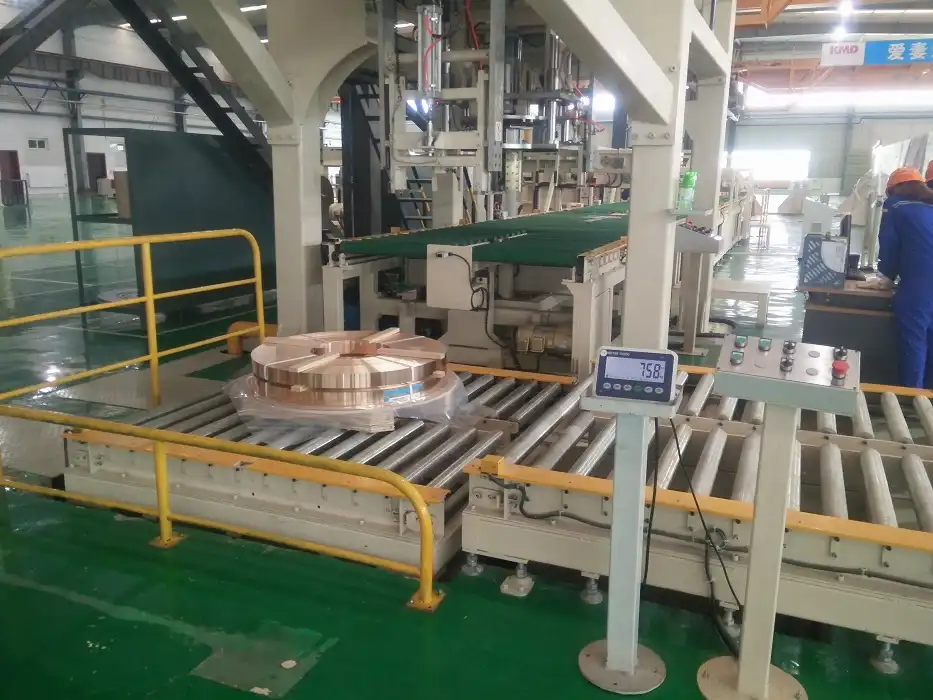Step-by-Step Process of Packing Steel Coils Using Machines
Packaging steel coils can be daunting without the right tools. Discover how automated machines make the process efficient and reliable, giving you peace of mind.
Packing steel coils using machines involves preparing the material, setting the coil on a coil upender, wrapping with a coil wrapping machine, and securing it with strapping. This automation improves consistency and minimizes human error.

Why automate the packing process of steel coils? Machines ensure uniformity, speed up operations, and reduce manual labor, making it the ideal solution for streamlined production.
1. What are the essential preparations before packing steel coils?
Precise preparation is key to effective coil packing. Understand why each step aligns for optimal outcomes.
Before packing steel coils, ensure they are clean and rust-free. Inspect for defects, measure dimensions, and calculate the number of coils. Proper preparation prevents damage and ensures a smooth wrapping process.

Understanding Preparations: A Closer Look
To prepare steel coils for packing, you must verify certain prerequisites. Each step mitigates risks, ensuring the process is both efficient and effective. Start with a thorough cleaning to remove any rust or oils that may cause future corrosion. Inspections follow, requiring a keen eye to detect any surface anomalies, dents, or defects. These imperfections, if overlooked, could compromise the wrapping process.
After cleansing and inspecting, measure the coils meticulously. Correct dimensions assist in setting up the machine, especially in determining the amount of wrapping material needed. Documenting each coil's weight, diameter, and width enhances operational accuracy. How many coils need packing is another critical consideration. This involves logistics planning to ensure material availability and machine readiness.
Consider environmental factors, such as humidity, which can affect the steel's condition. Storing coils in a controlled environment will help. Remember, these preliminary steps set the stage for successful coil packing, eliminating setbacks that could disrupt workflow or compromise product integrity.
Finally, collaboration with the engineering team ensures your workflow effortlessly transitions into the operation phase, maximizing efficiency and safety at every packing stage. With careful preparation, you're ready to leverage automation for precision and productivity.
2. How do machines automate the steel coil packing process?
Packaging steel coils manually can be time-consuming, inconsistent, and risky. Uncover how automation revolutionizes this process, boosting efficiency, safety, and precision.
Machines automate steel coil packing through mechanized conveyor systems and wrapping mechanisms. Automated equipment streamlines coil transport, aligns coils accurately, and applies protective materials uniformly. This minimizes errors and enhances productivity while ensuring coil integrity and worker safety.

Machines in Steel Coil Packing: The Core Components
In the quest for automation, it's crucial to understand the key components that make this transformation possible. Machines for packing steel coils are equipped with advanced technologies that coordinate various tasks, ensuring smooth and efficient operations.
| Component | Function | Benefit |
|---|---|---|
| Conveyor Systems | Transport coils reliably through packing stages | Reduces manual handling risks |
| Wrapping Units | Apply protective materials around coils | Ensures consistent wrapping quality |
| Control Systems | Coordinate machine actions, enhancing synchronization | Increases efficiency and precision |
Conveyor systems are the backbone of automated packing processes. They ensure coils move seamlessly through different stages, reducing bottlenecks common in manual handling. Wrapping units need to maintain consistent tension levels. This standardizes material application and minimizes coil surface damage.
Control systems are the brains behind operations, ensuring all steps align perfectly. They work by collecting data and making necessary adjustments in real-time. This level of precision boosts overall productivity and safety. Automation, thus, transforms coil packing into a seamless, error-free operation, far exceeding what manual processes can accomplish.
3. What are the common challenges and solutions in coil packing using machines?
Industrial manufacturers often face downtime, errors, and safety risks in manual coil packing. Discover how automation addresses these challenges, offering efficient and reliable solutions.
Common challenges in coil packing involve material waste, equipment setup errors, and safety concerns. Automated systems solve these by enhancing precision, reducing human errors, and implementing safety protocols. These advantages make coil packing more reliable and cost-effective.

Tackling Challenges in Automated Coil Packing
Understanding the pitfalls of coil packing is crucial for adopting effective solutions. Automated systems present unique features that tackle these common issues.
| Challenge | Solution | Benefit |
|---|---|---|
| Setup Errors | User-friendly interfaces for precise adjustments | Simplifies machine setup |
| Material Waste | Smart sensors optimize material use | Cuts costs and reduces environmental impact |
| Safety Concerns | Built-in safety mechanisms to protect operators | Enhances working environment safety |
One significant challenge in coil packing is setup errors. Incorrect configurations lead to inefficient cycles, causing downtime. Automated machines offer intuitive interfaces, reducing setup complexity and ensuring optimal settings.
Material waste can't be overlooked, either. Smart sensors in advanced systems track coil dimensions, automatically adjusting material use, thereby reducing unnecessary waste and associated costs.
Safety remains a top priority. Machines come with integrated safety features that shield operators from hazardous tasks. These include emergency stop buttons and alerts that keep the packing area secure.
By implementing automated systems, companies can overcome these challenges, leading to more efficient operations. As automation becomes integral to industrial packing, its role in shaping processes continues to grow.
Conclusion
Using machinery for packing steel coils enhances safety and efficiency, streamlining operations while minimizing risks. These systems offer notable benefits such as reduced errors and consistent quality. Innovations promise even greater enhancements in packaging, keeping industry practices efficient and cutting-edge.
Conclude with the benefits of using machinery for packing steel coils, such as improved safety and efficiency. Highlight key takeaways and potential future innovations in the industry.
